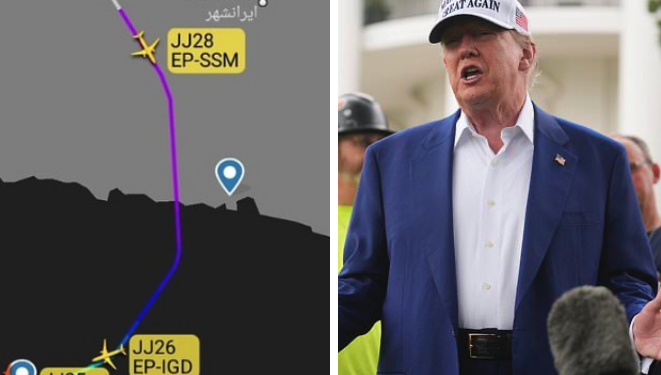Key Point Summary – Trump Heads to Situation Room
- President Trump met top generals amid escalating Iran-Israel conflict
- Israeli airstrikes hit over 60 targets in Tehran and western Iran
- Tehran plunged into blackouts as explosions lit up the night
- Three Iranian planes landed in Oman, fueling secret diplomacy rumors
- Trump declared Iran had “made a mistake” and his patience had ended
- U.S. remains on high alert with carrier groups repositioning
- Public fears global war as diplomatic efforts stall
Trump Drops the Gloves
President Donald Trump didn’t mince words. “They made a mistake,” he said, referring to Iran’s actions in the ongoing crisis.
On Wednesday afternoon, Trump left the Oval Office and descended into the White House Situation Room for a war council.
The reason? A rapidly escalating conflict between Iran and Israel that’s dragging the world to the edge of a larger war.
Inside the bunker, Trump met with his top military brass, including generals, intelligence chiefs, and national security aides. The tone was serious. The stakes were historic.
Bombs Fall, Blackouts Rise
That same day, the Israeli Air Force launched a third wave of devastating strikes on Iranian soil—just hours after pounding more than 40 sites near Tehran.
This round of strikes focused on western Iran, targeting long-range missile sites and suspected nuclear facilities.
Residents of Tehran reported massive explosions and plunging darkness. Whole districts lost power.
Trump Heads to Situation Room as Middle East Erupts
The blasts rocked the city. Air raid sirens howled. Videos showed fireballs streaking across the night sky.
Israel Defense Forces spokesman Effie Defrin said jets were targeting storage depots, mobile launchers, and “operatives attempting to recover munitions.”
Among the high-profile targets was a centrifuge factory. That facility—according to Israeli officials—played a key role in enriching uranium for nuclear weapons.
The IDF confirmed that over 70 aircraft took part in the full-day operation.
Ominous Silence From Iran
Despite the chaos, Iran’s government remained tight-lipped.
No formal statement. Or retaliation. No press conference. Just eerie silence.
But three Iranian aircraft quietly landed in Muscat, Oman—a historic site for U.S.–Iran diplomacy.
Two belonged to the government. The third came from Meraj Airlines, a private carrier with past ties to diplomatic missions.
Diplomacy or Desperation?
The mystery flights triggered global speculation. Was this an attempt at backchannel talks? Or were officials fleeing something darker?
Iran hasn’t said a word. Neither has Oman. But the timing is impossible to ignore.
Israel’s firepower rained down just as those planes touched the runway.
Meanwhile, back in Washington, Trump’s language turned from cautious to cold.
“They Had Their Chance”
Reporters asked Trump if he still hoped for a diplomatic resolution.
“It’s already run out,” he snapped. “They had 60 days. Plenty of time. They made a mistake.”
The remark sent shockwaves across NATO capitals. Was the U.S. about to join the fight?
Pentagon on Standby
Sources inside the Department of Defense confirmed that two carrier strike groups in the region are repositioning.
U.S. fighter jets remain grounded—but fueled and ready. Surveillance drones are already scanning the skies over Iran.
America hasn’t fired a shot. But its trigger finger is flexing.
Tehran in the Dark
The city of 9 million now sits under a cloud of smoke and anxiety.
Mass blackouts swept through Tehran after the second wave of Israeli strikes.
It’s unclear whether the outages were caused by direct hits or coordinated cyberattacks.
Either way, the result is the same: panic, fear, and a stunned population waiting for what’s next.
Civilians Brace for the Worst
Footage from inside Iran shows terrified residents forming long lines at bakeries, filling bathtubs with water, and preparing makeshift bunkers.
Public trust in the regime has cratered. Many fear their leaders won’t be able to shield them if a full-scale war breaks out.
One Tehran resident posted on social media, “No lights. No food. No truth. We are alone.”
Israel Signals It’s Not Done
Israeli officials say this was only the beginning.
“If necessary, we’ll hit again,” Defrin said in a blunt statement. “We will not allow Iran to develop weapons of mass destruction.”
The third wave of strikes targeted hardened missile depots deep in western Iran—regions previously untouched by conflict.
Global Reactions Split
U.S. allies are scrambling to respond.
The UK backed Israel’s right to defend itself. France urged calm. Germany offered to mediate.
China and Russia condemned the strikes, accusing Israel of reckless aggression.
At the UN, emergency talks stalled as diplomats traded barbs behind closed doors.
Trump Faces a Crucial Choice
Now, the spotlight swings back to Washington.
Trump can send in support—and risk dragging America into a Middle Eastern war. Or he can hold back and let Israel act alone.
Sources say he’s weighing all options. But with his trademark impatience showing, few believe he’ll sit idle for long.
The People Speak
Across the U.S., public opinion is split.
Some say it’s time to back Israel fully. Others warn this is how world wars begin.
“Don’t get us killed over someone else’s fight,” one viral tweet read.
Yet many others posted, “Iran’s been playing with fire. Time to finish it.”
Clock Ticking on Peace
The mystery in Muscat still hangs heavy. If talks are happening, they must move fast.
Every hour without diplomacy brings more bombs, more fear, and more danger.
Iran’s blackout may be physical—but the real darkness lies in what comes next.
Outlook: Brink of War
The world watches, breath held.
Tehran is smoldering. Israel is flying. Trump is watching.
Whether the next headline reads “peace” or “invasion” depends on what’s said behind those sealed doors in Washington and Oman.
Until then, history holds its breath—and the skies over Iran burn on.
Would you like this adapted into a breaking email alert or international broadcast version?




